Etched carnelian beads
Etched carnelian beads, or sometimes bleached carnelian beads, are a type of ancient decorative beads made from carnelian with an etched design in white, which were probably manufactured by the Indus Valley civilization during the 3rd millennium BCE. They were made according to a technique of alkaline-etching developed by the Harappans, and vast quantities of these beads were found in the archaeological sites of the Indus Valley civilization.[2][1][3][4] They are considered as an important marker of ancient trade between the Indus Valley, Mesopotamia and even Ancient Egypt, as these precious and unique manufactured items circulated in great numbers between these geographical areas during the 3rd millennium BCE, and have been found in numerous tomb deposits.[5]
Production technique
(3rd millennium BCE)
Etched carnelian beads with characteristic designs are widely known from various Indus Valley civilization sites dating to the 3rd millennium BCE, such as at Dholavira, and these beads "were exported to the Mesopotamian region during second half of 3rd millennium BC and were of extreme importance".[8][9]
The technique used in making etched carnelian beads has been the object of ethnographical studies, particularly by H.C. Beck.[10][11] It is rather complex and relies on delicate craftsmanship, etching chemical reactions and proper firing.[10] First, the bead has to be shaped and polished from its raw state and pierced in its center, in order to form a regular bead of the desired shape.[5] This process alone can take three to eight days of work.[5]
Then a chemical etching agent has to be formulated, which is typically a sticky paste formulated from an alkaline washing soda solution (Sodium carbonate) and plant juice, most commonly Capparis aphylla, a bush growing in dry or arid areas in Africa, Iran, Pakistan and India.[10] Once mixed, the texture of the paste also has to be just right to allow for a good spread without bleeding, thus permitting the creation of a beautiful design.[10] The paste, once applied, is left to dry, at which point it only forms a transparent varnish.[10][5]
The bead with its design than has to be fired at the proper temperature, not too hot lest the beads fractures, but hot enough so as to permit the chemical etching of the carnelian stone.[10] The result design comes out beautifully white, usually with some surface calcinated residues which can be easily brushed away.[10][5]
In 1933, Ernest Mackay studied the process as still being implemented in Sindh,[12] which was summarized by Gregory Possehl in the following terms:
"The process began with the juice extracted from the tips of young shoots of a bush called 'kirar' in Sindhi (Capparis aphylla). The informant then ground washing soda to a fine powder and mixed it with water in a cup. He poured a small quantity of this on the kirar and rubbed the whole carefully together to a semfluid mass. Then the craftsman strained this mixture through a piece of linen into a large empty mussel shell, and the "paint" was ready. The paint was applied to a carnelian stone using a reed pen. The painted stone was then allowed to dry, first in the hand, then by placing it on a metal plate over a charcoal fire. When fully dry, the carnelian was covered with live coals and the fire fanned for about five minutes. The piece was then removed from the heat and allowed to cool slowly for about 10 minutes under an inverted cup, at which point the craftsman rubbed his piece of carnelian briskly with a rag and handed it over for inspection. It was perfect!"
Mesopotamia
Etched carnelian beads from the Indus were found in the tombs of the Royal Cemetery of Ur, dating to 2600–2450 BCE.[15] They are an important marker of Indus–Mesopotamia relations in ancient times. The Neo-Sumerian ruler Gudea (c. 2100 BCE), in his Gudea cylinders (cylinder B XIV), mentioned his procurement of "blocks of lapis lazuli and bright carnelian from Meluhha."[16][17] Meluhha is generally identified with the Indus region, and there are no known mentions of Meluhha after 1760 BCE.[18] It is thought that these carnelian beads were considered as an important status symbol in Sumerian society.[5]
 Etched carnelian beads excavated in tomb PG 1133 of the Royal Cemetery of Ur, 2600-2500 BCE.[19]
Etched carnelian beads excavated in tomb PG 1133 of the Royal Cemetery of Ur, 2600-2500 BCE.[19]
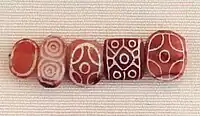
.jpg.webp)
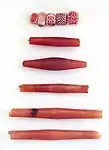 Indus Valley Civilization carnelian beads excavated in Susa. Louvre Museum
Indus Valley Civilization carnelian beads excavated in Susa. Louvre Museum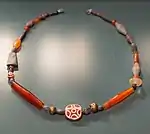
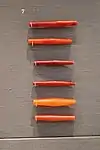 Harappan carnelian beads, excavated in the Royal Cemetery at Ur. British Museum
Harappan carnelian beads, excavated in the Royal Cemetery at Ur. British Museum
Local Mesopotamian creations (Akkadian and Ur III periods, circa 2100 BCE)
(c. 2094–2047 BCE)
NIN-a-ni....................... "his Lady,"
DSHUL-GI.................... "Shulgi"
NITAH KALAG ga........ "the mighty man"
LUGAL URIM KI ma..... "King of Ur"
LUGAL kien-................. "King of Sumer"
gi kiURIke..................... "and Akkad,"
nam-ti-la-ni-sze3........... "for his life"
a mu-na-ru................... "dedicated (this)"
Some of these beads of probable Indus provenance were engraved by Sumerian kings for dedication purposes.[31] Shulgi in particular is known for having engraved two carnelian beads with dedication to his gods.[31]
One of them was found in Susa by Jacques de Morgan and is now in the Louvre Museum. Its inscription reads: "Ningal, his mother, Shulgi, god of his land, King of Ur, King of the four world quarters, for his life dedicated (this)" (Louvre Museum, Sb 6627).[32][33][34] It is considered that this bead belongs to the smaller type of the "classically Harappean" beads, and was initially imported from the Indus Valley, and then engraved by Shulgi.[35]
The other carnelian bead is in the British Museum, its inscription reads: "To Ninlil, his Lady, Shulgi, mighty man, king of Ur, king of the lands of Sumer and Akkad, dedicated (this bead) for his (own) life" (British Museum, BM 129493).[36][37]
These two examples show that there was a level of Mesopotamian adaptation, and appropriation of the etching technology, in using or decorating carnelian beads, since there are no known beads with textual inscriptions among the carnelian beads excavated in the Indus region.[38][39] In Mesopotamia, the tradition of inscribing beads of precious stones with religious dedications was an ancient one, as a lapis-lazuli bead belonging to king Mesannepada and dating to c. 2550 BCE is also known.[40][41][42] Such dedication beads were created much later too, such as the agate bead dedicated by Sargon II for Damkina in the 8th century BCE.[43][44]
Some of the designs on the etched carnelian beads found in Mesopotamia are also typically Mesopotamian, and have no equivalent in the Indus region, such as stepped patterns, guilloché designs, or a Mesopotamian sun symbol in one case.[39] This again suggests the existence of Mesopotamian workshops dedicated to the creation of some local designs of etched carnelian beads, the carnelian material itself most probably coming from the Indus region.[39][45]
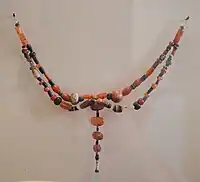 Jewelry with components from the Indus, Central Asia and Northern-eastern Iran found in Susa, Akkadian Empire or Ur III period. Louvre Museum.[45]
Jewelry with components from the Indus, Central Asia and Northern-eastern Iran found in Susa, Akkadian Empire or Ur III period. Louvre Museum.[45]_found_in_Susa_excavations%252C_Akkadian_or_Ur_III_period.jpg.webp) Four oval-shaped carnelian beads with guilloché pattern and one cylindrical bead with stepped pattern (top right) found in Susa excavations, Akkadian Empire or Ur III period. The carnelian is most probably from the Indus region, but the designs are typically Near-Eastern.[45][39]
Four oval-shaped carnelian beads with guilloché pattern and one cylindrical bead with stepped pattern (top right) found in Susa excavations, Akkadian Empire or Ur III period. The carnelian is most probably from the Indus region, but the designs are typically Near-Eastern.[45][39]
Egypt
A few etched carnelian beads have also been found in ancient Egypt, thought to have been imported from the Indus Valley Civilization through Mesopotamia, this time as part of Egypt-Mesopotamia relations. Examples are known dating to the late Middle Kingdom c. 1800 BCE. London, Petrie Museum of Egyptian Archaeology, ref. UC30334.[46][47]
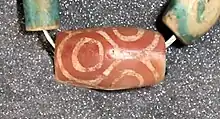 A rare etched carnelian bead found in Egypt, thought to have been imported from the Indus Valley civilization through Mesopotamia. Late Middle Kingdom. London, Petrie Museum of Egyptian Archaeology, ref. UC30334.[48][49]
A rare etched carnelian bead found in Egypt, thought to have been imported from the Indus Valley civilization through Mesopotamia. Late Middle Kingdom. London, Petrie Museum of Egyptian Archaeology, ref. UC30334.[48][49].jpg.webp) Etched carnelian bead, Egypt Ptolemaic Period, London, Petrie Museum of Egyptian Archaeology UC51264 (detail)
Etched carnelian bead, Egypt Ptolemaic Period, London, Petrie Museum of Egyptian Archaeology UC51264 (detail)
Greece
Some rare examples of etched carnelian beads, have been found in archaeological excavations in ancient Greece, pointing to ancient trade relations with Mesopotamia and the Indus Valley civilization. One such object is visible in the Archaeological Museum of Aegina, the westernmost known occurrence of this type of objects.[50]
Central South East and East Asia
China
Etched Carnelian beads of Indus valley origin have been excavated from various archaeological sites in China dating from Western Zhou and Spring and Autumn period (early half of 1st millennium BCE) to Han and Jin dynasties.[51] About 55 such specimens have been found, mostly from southern (Yunnan and Guangdong) and northwestern China (Xinjiang), in burial remains.[51] They are red in colors, with white motifs, and were manufactured with drilling techniques only known in India.[51] They are considered as imported goods, and indicate early cultural exchanges.[51]
Tajikistan
Etched carnelian beads have been found from female Saka burials dated 8th-6th century BCE in Pamir, Tajikistan, all likely imported from India.[51]
South East Asia
Etched carnelian beads have been noted at Thailand (4th century BCE-4th century AD), Vietnam (3rd-2nd century BCE, Sa Huynh, Oc Eo cultures), Philippines (manunggul cave, 9th-2nd century BCE), Indonesia, Malaysia (Kuala Selinsing, Perak, 200 BCE, possibly much older), Myanmar (site near Mandalay, 8th-5th century BCE).[52]
External links
- Olé, Clément (18 January 2019). "Etching Carnelian Beads: Understanding And Reproducing An Ancestral Technique". World History Lab. The British Museum.
References
- British Museum notice: "Gold and carnelians beads. The two beads etched with patterns in white were probably imported from the Indus Valley. They were made by a technique developed by the Harappan civilization" Photograph of the necklace with museum notice
- For the etching technique, see MacKay, Ernest (1925). "Sumerian Connexions with Ancient India". The Journal of the Royal Asiatic Society of Great Britain and Ireland (4): 699. JSTOR 25220818.
- Guimet, Musée (2016). Les Cités oubliées de l'Indus: Archéologie du Pakistan (in French). FeniXX réédition numérique. p. 355. ISBN 9782402052467.
- "Such beads occur fairly largely on all the principal sites of the Harappan civilisation." in Pakistan Archaeology No.2. 1965. p. 21.
- Art of the first cities : the third millennium B.C. from the Mediterranean to the Indus. The Metropolitan Museum of Art. 2003. pp. 395–396.
- Chanhudaro, Ernest J. Mackay, American Oriental Society, 1943
- Mackay, Ernest (1935). Indus civilization. pp. Plate K, Item Nb 5.
- Nandagopal, Prabhakar (2018). Walking with the UnicornSocial Organization and Material Culture in Ancient South Asia. Archaeopress Archaeology. pp. 475–485.
- McIntosh, Jane (2008). The Ancient Indus Valley: New Perspectives. ABC-CLIO. p. 185. ISBN 978-1-57607-907-2.
- "World History Lab". The British Museum. 18 January 2019.
- Beck H.C. Etched carnelian beads. The Antiquaries Journal 13: 1933: 384–398. Beck, Horace C. (8 January 2012). "Etched Carnelian Beads". The Antiquaries Journal. 13 (4): 384–398. doi:10.1017/S000358150003883X.
- Mackay, Ernest J. h (1943). Chanhu Daro Excavations 1935-36.
- Possehl, Gregory L. (2002). The Indus Civilization: A Contemporary Perspective. Rowman Altamira. p. 96. ISBN 978-0-7591-0172-2.
- MacKay, Ernest (1925). "Sumerian Connexions with Ancient India". The Journal of the Royal Asiatic Society of Great Britain and Ireland (4): 699. JSTOR 25220818.
- McIntosh, Jane (2008). The Ancient Indus Valley: New Perspectives. ABC-CLIO. pp. 182–190. ISBN 9781576079072.
- Moorey, Peter Roger Stuart (1999). Ancient Mesopotamian Materials and Industries: The Archaeological Evidence. Eisenbrauns. p. 87. ISBN 978-1-57506-042-2.
- Moorey, Peter Roger Stuart (1999). Ancient Mesopotamian Materials and Industries: The Archaeological Evidence. Eisenbrauns. p. 97. ISBN 978-1-57506-042-2.
- "MS 2814 - The Schoyen Collection". www.schoyencollection.com.
- Hall, H. R. (Harry Reginald); Woolley, Leonard; Legrain, Leon (1934). Ur excavations. Trustees of the Two Museums by the aid of a grant from the Carnegie Corporation of New York. p. 133.
- Louvre Museum reference Sb 17751 "Site officiel du musée du Louvre". cartelfr.louvre.fr.
- Guimet, Musée (2016). Les Cités oubliées de l'Indus: Archéologie du Pakistan (in French). FeniXX réédition numérique. pp. 354–355. ISBN 9782402052467.
- Art of the first cities : the third millennium B.C. from the Mediterranean to the Indus. p. 395.
- Nandagopal, Prabhakar (2018-08-13). Decorated Carnelian Beads from the Indus Civilization Site of Dholavira (Great Rann of Kachchha, Gujarat). Archaeopress Publishing Ltd. ISBN 978 1 78491 917 7.
- "Indus carnelian bead found in Nippur Mesopotamia". www.metmuseum.org.
- AN1925.261
- (RIME 3/2, p. 161-162)
- "DINGIR.NIN.LILA / NIN-A-NI / DINGIR.SHUL.GI / NITA-KALAG.GA / LUGAL URI/ .KI-MA / LUGAL.KI.EN / GI KI-URI3.KI / NAM.TI.LA NI.SHE3/ A MU.NA.RU." Inscription Translation: "To Ninlil, his lady, Shulgi, mighty man, King of Ur, King of Sumer and Akkad, has dedicated (this stone) for the sake of his life." "cylinder seal / bead". British Museum.
- "CDLI-Archival View". cdli.ucla.edu.
- Sb 6627 Potts, Professor Daniel T. (1999). The Archaeology of Elam: Formation and Transformation of an Ancient Iranian State. Cambridge University Press. p. xiv. ISBN 978-0-521-56496-0.
- Art of the First Cities: The Third Millennium B.C. from the Mediterranean to the Indus. Metropolitan Museum of Art. 2003. p. 243. ISBN 978-1-58839-043-1.
- McIntosh, Jane (2008). The Ancient Indus Valley: New Perspectives. ABC-CLIO. p. 185. ISBN 978-1-57607-907-2.
- Louvre Museum, Room 305 display 4 Louvre notice.
- Description with photograph and inscription "Ningal, his mother, Shulgi, god of his land, King of Ur, King of the four world quarters, for his life dedicated (this)" in : Potts, D.T. The Archaeology of Elam. p. 134, Plate 5.2.
- "Perle au nom du roi Shulgi vouée à la déesse Ningal Photo (C) RMN-Grand Palais / Hervé Lewandowski". Musée du Louvre.
- Roux, Valentine (2017). Cornaline de l’Inde: Des pratiques techniques de Cambay aux techno-systèmes de l'Indus (in French). Éditions de la Maison des sciences de l’homme. p. 364, paragraph 41. ISBN 978-2-7351-1868-7.
- (RIME 3/2, p. 161-162)
- "DINGIR.NIN.LILA / NIN-A-NI / DINGIR.SHUL.GI / NITA-KALAG.GA / LUGAL URI/ .KI-MA / LUGAL.KI.EN / GI KI-URI3.KI / NAM.TI.LA NI.SHE3/ A MU.NA.RU." Inscription Translation: "To Ninlil, his lady, Shulgi, mighty man, King of Ur, King of Sumer and Akkad, has dedicated (this stone) for the sake of his life." "cylinder seal / bead". British Museum.
- Robinson, Andrew (2015). The Indus: Lost Civilizations. Reaktion Books. pp. 99–100. ISBN 978-1-78023-541-7.
- Art of the First Cities: The Third Millennium B.C. from the Mediterranean to the Indus. Metropolitan Museum of Art. 2003. p. 243. ISBN 978-1-58839-043-1.
- Description with photograph: Art of the First Cities: The Third Millennium B.C. from the Mediterranean to the Indus. Metropolitan Museum of Art. 2003. p. 143. ISBN 978-1-58839-043-1.
- Orientalia: Vol. 73. Gregorian Biblical BookShop. p. 183.
- For the discovery of the "Treasure of Ur" and detailed content of the jar, see: Parrot, André (1965). "Les Fouilles de Mari". Syria. Archéologie, Art et histoire. 42 (3): 197–225. doi:10.3406/syria.1965.5808.
- Roux, Valentine (2017). Cornaline de l’Inde: Des pratiques techniques de Cambay aux techno-systèmes de l'Indus (in French). Éditions de la Maison des sciences de l’homme. p. 331, note 4. ISBN 978-2-7351-1868-7.
- Louvre Museum AO1936 "Réunion des Musées Nationaux-Grand Palais -". www.photo.rmn.fr.
- Art of the First Cities: The Third Millennium B.C. from the Mediterranean to the Indus. Metropolitan Museum of Art. 2003. pp. 300–301. ISBN 978-1-58839-043-1.
- Grajetzki, Wolfram (2014). "Tomb 197 at Abydos, Further Evidence for Long Distance Trade in the Middle Kingdom". Ägypten und Levante / Egypt and the Levant. 24: 159–170. doi:10.1553/s159. JSTOR 43553796.
- Stevenson, Alice (2015). Petrie Museum of Egyptian Archaeology: Characters and Collections. UCL Press. p. 54. ISBN 9781910634042.
- Grajetzki, Wolfram (2014). "TOMB 197 AT ABYDOS, FURTHER EVIDENCE FOR LONG DISTANCE TRADE IN THE MIDDLE KINGDOM". Ägypten und Levante / Egypt and the Levant. 24: 159–170. doi:10.1553/s159. JSTOR 43553796.
- Stevenson, Alice (2015). Petrie Museum of Egyptian Archaeology: Characters and Collections. UCL Press. p. 54. ISBN 9781910634042.
- Art of the First Cities: The Third Millennium B.C. from the Mediterranean to the Indus. Metropolitan Museum of Art. 2003. p. 261, Object 166 a and b. ISBN 978-1-58839-043-1.
- Zhao, Deyun (2014). "Study on the etched carnelian beads unearthed in China" (PDF). Chinese Archaeology. 14: 176–181 – via The Institute of Archaeology (CASS).
- Glover, Ian C.; Bellina, Bérénice (2001). "Alkaline Etched Beads East of India in the Late Prehistoric and Early Historic Periods". Bulletin de l'École française d'Extrême-Orient. 88: 191–215. ISSN 0336-1519.
.jpg.webp)
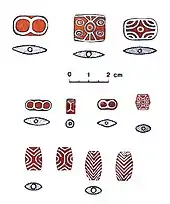

.jpg.webp)
.jpg.webp)
.jpg.webp)
.jpg.webp)